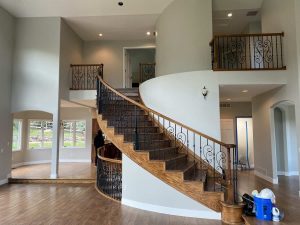

In the ever-evolving realm of interior design, some elements seem to be perennially in and out of vogue. One such feature, the humble mdf dado rail, is quietly making its resurgence as a key player in modern home aesthetics. Once a staple of grand historic interiors, these decorative moldings are finding new life in contemporary settings, injecting a touch of classic elegance and dimension into our minimalist and industrial spaces.
Despite their historical association, MDF dado rails are proving to be anything but outdated. Their versatility has made them a popular choice among interior designers looking to add texture and a sense of proportion to walls that might otherwise seem flat and uninspired. What’s more, the material’s affordability and ease of maintenance align perfectly with the pragmatic demands of the modern homeowner.
The Aesthetic Appeal
The aesthetic appeal of MDF dado rails lies in their ability to create visual interest without overwhelming the space. These wooden strips, typically installed one third up from the floor to two-thirds of the wall height, divide the wall space into pleasing proportions, harking back to traditional wainscoting and paneling. This design feature not only serves a practical purpose by protecting walls from the bumps and scuffs of everyday life, but it also elevates the entire room by adding an architectural detail that catches the eye.
The sharp lines and defined edges of MDF dado rails can also act as an anchor for the room’s design, especially when contrasting against a different wall color or texture. Their presence can make a bold, yet not intrusive, design statement, particularly in spaces meant for socializing or relaxation, such as living rooms and dining areas.
Functional Uses
While the aesthetic virtues of MDF dado rails are compelling, their functional uses are equally significant. By dividing the wall into distinct sections, designers can employ a technique known as “asymmetrical balance,” which helps create a space that feels harmonious and comfortably furnished. This is particularly beneficial in open-plan homes, where segmented areas must coexist within a single space.
Additionally, dado rails offer a practical way to break up the use of paint or wallpaper, providing a visual pause that can prevent an overwhelming or monotonous effect. They serve as a delineation between different color schemes or patterns, which can be particularly useful in rooms with high ceilings.
Installation and Maintenance
One of the reasons for the renewed popularity of MDF dado rails is the practicality of their installation. Unlike traditional dado rails made of plaster or wood, MDF is a relatively lightweight material that’s also pre-primed for easy painting. Designers and homeowners who prefer to tackle home improvement projects themselves appreciate its user-friendly nature.
MDF dado rails are also low-maintenance, requiring only occasional wipe-downs to keep them looking fresh. This is in stark contrast to more elaborate wall treatments that may require specialized cleaning or frequent touch-ups. For busy households, the ability to easily maintain a beautiful room is a considerable asset.
Modern Applications
In contemporary interior design, MDF dado rails are not simply replicating their historic use but being reinterpreted in a modern context. They can be found in homes ranging from mid-century modern to industrial chic, always adapting to the aesthetics of the space they inhabit.
For a more rustic or farmhouse look, MDF dado rails can be painted in chalky finishes to lend a weathered, hand-crafted appeal. In contrast, sleek, metropolitan environments may call for the sharp, clean lines of an enamel or high-gloss finish. Depending on the design vision, dado rails can blend or stand out, subtly enhancing the room’s character.
Conclusion
The beauty of MDF dado rails lies in the way they subtly underscore the overall design scheme of a space. They are a testament to the endurance of tasteful design elements that, when used with intention, have the power to transform our living environments. Whether as a nod to the past or a statement of contemporary sophistication, these unassuming moldingshave proven their place in the annals of interior design, weaving a timeless thread through the fabrics of the homes they adorn.







